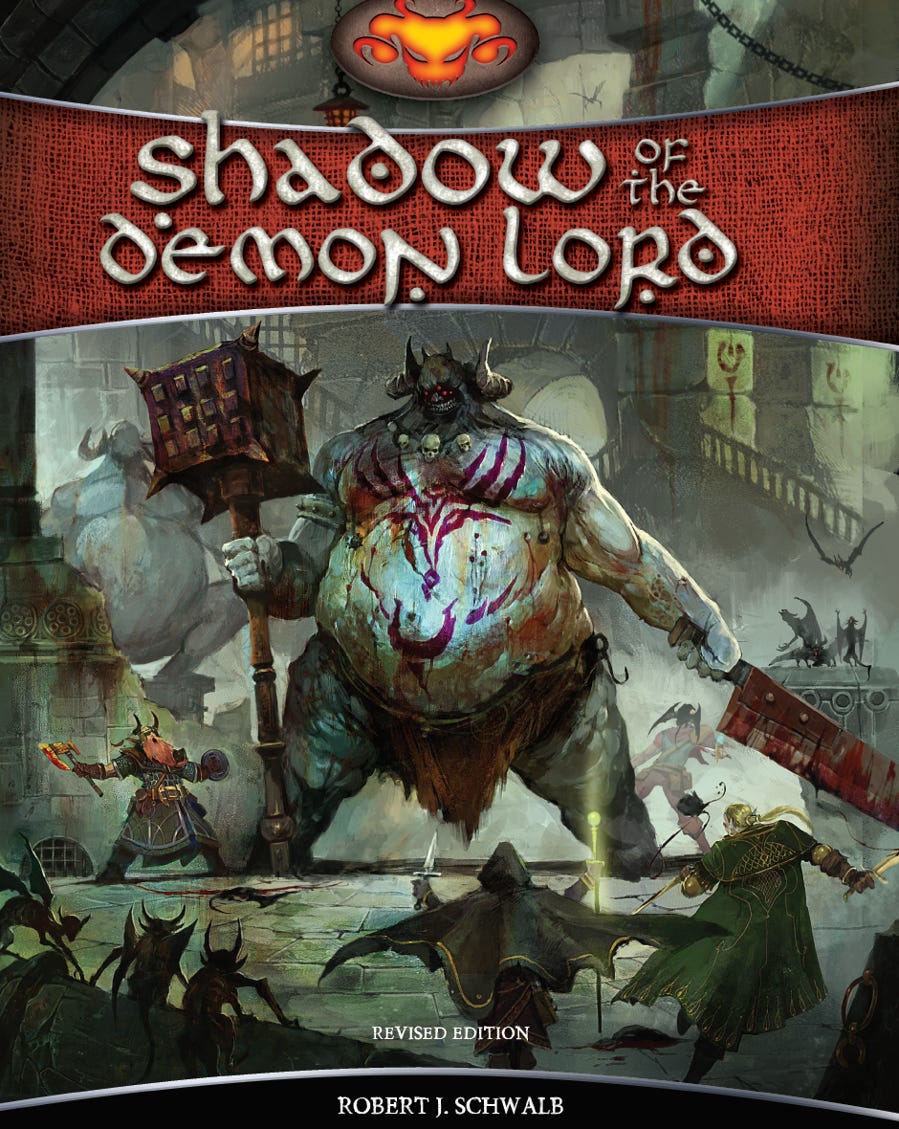Shiny Things: Shadow of the Demon Lord Initiative
All that glitters is gold, right? Hacking initiative from SotDL
I wrote in my first post that I’m often enamoured with “shiny things”. These are interesting distracting things I happen upon in reading other rpg books I find especially inspiring!
Shadow of the Demon Lord is a book that I’ve heard a lot about in my time in rpgs. To me, it falls into an interesting category of rpgs that aren’t exactly D&D but the visions of individual design talent that previously worked for the franchise. This certainly isn’t a bad thing, the body of work also includes Blue Rose which I adore deeply.
In terms of content, SotDL wears its thematic influences on its sleeve. The preface mentions Warhammer Fantasy and the impact of the setting on the game is palpable in nearly everything. The game is dark in a way that revels in its own evil and cruelty. In light of Blue Rose, I’ve been contemplating, “What makes a game romantic fantasy?”
Reading SotDL, I’ve come to one conclusion: it’s not this.
The way the system functions is definitely reminiscent of D&D 5e, for better or for worse. I’ve occasionally found people describing SotDL as “What D&D 5e should’ve been,” which I don’t know if I agree with. Shadow of the Demon Lord is certainly a game that evokes a philosophy similar to 5e but it’s much leaner and meaner with enough divergence that it forms a distinct identity.
I sometimes have a hard time parsing rpg books, often because of the layout or writing style. In reading SotDL, I relied on this readthrough by Serf and CHIMlord to get a vague idea before reading the original gametext for more specific details.
Shadow of the Demon Lord
The thing that really called out to me in reading SotDL was the initiative system. Technically, SotDL doesn’t use an initiative system; but structures combat into rounds with shared turns. I, personally, tend to call any mechanic that decides the order of play an ‘initiative system,’ even if it doesn’t fit perfectly.
In combat, the key thing that determines when you act is the type of ‘turn’ you take:
Fast Turns allow you to use an action or move, but not both.
Slow Turns allow you to use an action and move, with the action being able to take place at any point during the movement.
I think the use of turn typing to determine when you go in combat is really smart. At the start of every round you’re presented with an interesting choice of what to do. Agency and decision making is at the forefront of combat, and I really like that.
Turn Order:
Players (Fast Turn)
GM (Fast Turn)
Players (Slow Turn)
GM (Slow Turn)
There’s two rules that apply in combat and have very interesting knock-on effects:
Players always go before the GM. I think this is a good decision, it makes the effect of choosing a turn type very deterministic. Choosing to take a Fast Turn ensures that you act before anyone else which makes planning very easy.
Effects that last ‘1 round’ continue until the end of the next round. This one is slightly weirder in my eyes. SotDL standardises effects to mostly resolve at the end of rounds so, in a way, it makes sense — but it also provides the potential to double-tap an enemy that chooses a Slow Turn twice in a row.
Hacking It
I think that Shadow of the Demon Lord’s initiative system fits into a sort of innovation that is so simple and almost obvious. I have similar feelings about clocks in Blades in the Dark — it’s such a simple idea that you almost facepalm about the fact you didn’t think of it first.
Because of this, I really think that you can’t mess with it too much without ruining the magic of it.
Here’s a few thoughts I’ve had about how to hack it.
Two-Action Slow Turns
Slow Turns allow you to use two actions.
In this iteration, movement also becomes a type of action that you can take. I think this is kind of interesting as an idea but it might also backfire horribly. Allowing two actions means that you have to balance around the possibility of a lot more attacks and damage per round.
The Black Hack
In The Black Hack, everyone makes a test at the start of round1 and success or failure determines whether go before or after the enemies. In theory, I like this a lot! It’s simple and slick, I find it very cool and it works really well with the roll-under system The Black Hack uses.
In practice, I’ve found that I don’t really like how initiative works. I’ve playtested it a lot in my own games, and I always feel like it is strangely clunky. Failing the roll is also a bit too punishing for my taste. I think an interesting experiment might be combining this initiative system with SotDL.
Merging the two systems, a round might look like:
Players (Fast Turn)
GM (All)
Players (Slow Turn)
Here’s a few thoughts about it:
I think this necessitates Slow Turns allowing two actions, the benefit of a move gets lost if every enemy can potentially move before you act.
Enemies might have to have turns of unequal impact to replicate the effect of taking Fast Turns and Slow Turns but within the same shared turn. I hate this!
The ‘1 round’ rule has to be reworked because creating an effect using a Fast Turn means that it will always affect enemies twice.
The Black Hack uses a system of Moments rather than rounds but they’re called rounds here for simplicity.





LANCER also has an interesting way of doing initiative. I like the back-and-forth initiative method that lancer uses.